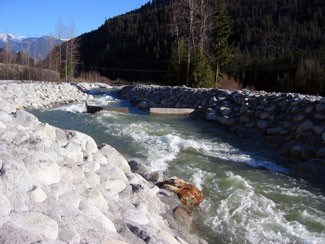Kayakers are one step closer to paddling the new kayak park off the Rutherford Creek but it still remains to be seen if the facility can open this season.
For the first time ever the park was flushed to its full capacity this week as the maximum flow of water was diverted from the river through the nearby powerhouse and into the park.
While that was a milestone in itself, the test revealed that there are still some problem spots in the channel, which will need to be fixed before the park can open.
"The sore spots at lower flows are the sore spots at high flows so there’s not too much changed that way," said Stuart Smith, a director of the Whitewater Kayaking Association of British Columbia who was at the site on Tuesday to see the full flows in the park.
The delay is just part of a series of delays which have plagued the paddling community and the energy company for more than a year.
Under the agreement with Cloudworks Energy, the power company which built the run-of-river energy project on the Rutherford, the kayak park was to open in June 2004. This was part of a deal with the local paddling community who were trying to stop the power company from reducing the water in one of their favourite kayaking spots. Together they worked on a deal to build a facility for the paddlers. The park is designed so that the paddlers can control the water flows and change the course to varying degrees of difficulty. A teaching pond was also built for beginners.
But, just as Cloudworks was putting the finishing touches on their plant, an unforeseen event pushed back the entire process.
The plant has two generators. More than a year ago a casing for one of the generators fell off a truck at Horseshoe Bay on its way to the powerhouse. It had been driven all the way from the Gulf of Mexico after being built in Brazil.
General Electric had to completely rebuild the generator casing, a process which took about a year.
"Once the incident happened it would have been very hard to commission this kayak park because we could never get all of the water through and actually what the kayakers need to see is the full water so they see what the different obstructions (are) and the fun they can have," said John Johnson, a principal with Cloudworks.
This weekend the second generator was up and running and the full diversion was at last sent through the park. But Smith said there are four or five "holes" in the channel, which need to be fixed.
"We need to change the way the water flows through them so that they don’t have the possibility of keeping someone in them," said Smith.
"Holes in the river are fun. We try to find those and play in them. But unfortunately in the course, because it’s so narrow, there’s places where there’s holes and there’s a wall on either side so you can’t get out. So we need to make it so it’s a little safer for people."
Once the problem spots are fixed, the park then needs to be tested by paddlers at different flow levels to see if it’s safe. Only then can it be officially commissioned.
That means there’s a very tight timeline if the park is to open this season. It will be based in part upon Mother Nature, said Smith.
If the river isn’t high enough, Cloudworks will not be able to divert the full flow of water into the kayak channel.
"There’s still the issue of whether we’ll have enough high flows this year to actually complete all that testing or not," said Smith. "Only the weather gods will know that for sure."
If the weather does not co-operate, the kayakers will have to wait until the next run off in the spring.
"We’re a little frustrated but on the other hand there’s not really much we can do or they can do so it’s just one of those things – you just have to wait until we get going," said Smith. "It’ll happen.
"It’s going to be nice and exciting. There’s lots of fun stuff already forming out there even though we don’t have a lot of our obstacles in there so (we) only anticipate that it’s going to get much better."
Johnson recognizes it’s been a frustrating process for the kayaking community and said the company has been pushing to get the second machine running. The push now is to get the testing done by mid-August before the river gets a little drier.
And while the rain in recent weeks has been good, the sunshine will help more now to create more run off.
"These are very volatile rivers," said Johnson. "The sunshine’s even better for us (than the rain) this time of year because it melts the glacier and the river comes up by itself. The only thing that really hurts is overcast, cool and no rain. And so, that’s just a function of Mother Nature. When she’s ready she’ll put enough water through there."




